| Listing 1 - 10 of 14 | << page >> |
Sort by
|
Book
ISBN: 9898010150 Year: 2006 Publisher: Casal de Cambra : Caleidoscópio,
Abstract | Keywords | Export | Availability | Bookmark
 Loading...
Loading...Choose an application
- Reference Manager
- EndNote
- RefWorks (Direct export to RefWorks)
Guerre --- Histoire ancienne --- Histoire --- Guerre --- Histoire ancienne --- Histoire
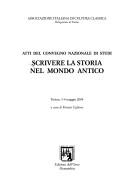
ISBN: 8876948961 Year: 2006 Publisher: Alessandria Edizioni dell'Orso
Abstract | Keywords | Export | Availability | Bookmark
 Loading...
Loading...Choose an application
- Reference Manager
- EndNote
- RefWorks (Direct export to RefWorks)
Conferences - Meetings --- History, Ancient --- Historiography --- Historiographie ancienne --- Histoire ancienne --- Historiographie
Book
ISSN: 01847155 ISBN: 9782251005324 9782251005713 2251005323 9782251005737 9782251005867 2251005714 2251005730 2251005862 Year: 2006 Volume: 502 Publisher: Paris Belles Lettres
Abstract | Keywords | Export | Availability | Bookmark
 Loading...
Loading...Choose an application
- Reference Manager
- EndNote
- RefWorks (Direct export to RefWorks)
History, Ancient --- Histoire ancienne --- Early works to 1800 --- Ouvrages avant 1800 --- History, Ancient.
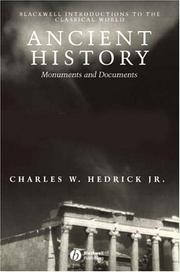
ISBN: 1405106581 9781405106573 9781405106580 1405106573 Year: 2006
Abstract | Keywords | Export | Availability | Bookmark
 Loading...
Loading...Choose an application
- Reference Manager
- EndNote
- RefWorks (Direct export to RefWorks)
History, Ancient --- Study and teaching. --- Sources. --- Historiography. --- Histoire ancienne --- Etude et enseignement --- Sources --- Historiographie --- History [Ancient ] --- Historiography --- Study and teaching
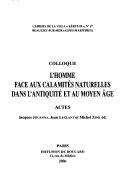
ISBN: 2877541835 9782877541831 Year: 2006 Volume: 17 Publisher: Paris : Académie des inscriptions et belles-lettres,
Abstract | Keywords | Export | Availability | Bookmark
 Loading...
Loading...Choose an application
- Reference Manager
- EndNote
- RefWorks (Direct export to RefWorks)
Natural disasters --- History, Ancient --- Civilization, Medieval --- Catastrophes naturelles --- Histoire ancienne --- Civilisation médiévale --- Congresses --- Congrès --- Civilisation médiévale --- Congrès --- Ancient history
Book
ISBN: 2753502048 Year: 2006 Volume: . 2 Publisher: Rennes Presses universitaires de Rennes
Abstract | Keywords | Export | Availability | Bookmark
 Loading...
Loading...Choose an application
- Reference Manager
- EndNote
- RefWorks (Direct export to RefWorks)
Culture --- History, Ancient --- Body language --- Histoire ancienne --- Langage du corps --- History --- Congresses --- Histoire --- Congrès --- Studies in the fine arts. --- Congrès --- Ancient socio-cultural history --- Iconography --- Bodies --- Congresses. --- Art antique --- Gestes --- Regard --- Corps humain --- Thèmes, motifs --- Dans l'art
Book
ISBN: 9783700137290 370013729X Year: 2006 Volume: 348. 26 Publisher: Wien : Verlag der Österreichischen Akademie der Wissenschaften,
Abstract | Keywords | Export | Availability | Bookmark
 Loading...
Loading...Choose an application
- Reference Manager
- EndNote
- RefWorks (Direct export to RefWorks)
History, Ancient --- Histoire ancienne --- Chronology --- Chronologie --- Greece --- Italy, Southern --- Grèce --- Mezzogiorno (Italie) --- History --- Histoire --- Excavations (Archaeology) --- Grèce --- Italy --- Mediterranean Region --- Antiquities. --- Chronology. --- Bronze age --- Civilization --- E-books --- Excavations (Archaeology) - Greece. --- Excavations (Archaeology) - Italy. --- Civilisation égéenne --- Protohistoire
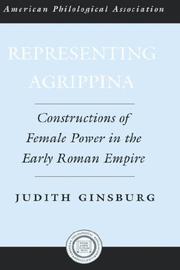
ISBN: 9780195181418 0195181417 Year: 2006 Volume: 50 Publisher: Oxford New York : Oxford University Press,
Abstract | Keywords | Export | Availability | Bookmark
 Loading...
Loading...Choose an application
- Reference Manager
- EndNote
- RefWorks (Direct export to RefWorks)
Agrippina the Younger, wife of the emperor Claudius and mother of his successor Nero, wielded power and authority at the center of the Roman empire in ways unmatched by almost any other woman in Roman history. Such, at least, is the portrait of Agrippina delivered by our sources and perpetuated in modern scholarship. In this posthumous work, Judith Ginsburg provides a fresh look at both the literary and material representations of Agrippina. Her painstaking dissection of the rhetoric contained in portrayals by historians exposes their motivations. The objectives, as Ginsburg shows, went beyond the display of literary flourishes. The historians aimed to blur the boundaries between the domestic and the imperial realms, deploying the image of Agrippina as domineering wife and mother to suggest the flaws and instability of the regime, a dysfunctional family betraying an erratic and unpredictable system of governance. Distorted stereotypes of the "wicked stepmother," the domineering woman, and the sexual transgressor were applied to underscore the violations of status and disruption of gender relations that characterized the imperial administration. With as keen an eye for visual (mis)representations as for literary ones, Ginsburg also examines how depictions of Agrippina on coinage and statuary - as matron and priestess, emblematic of domestic rectitude and public piety, and a central figure in the continuity of the dynasty - provide a stark contrast with the written evidence. Unlike previous treatments, Ginsburg seeks neither to condemn nor to rehabilitate Agrippina. Nor does she endeavor to exhume the "real Agrippina." Ginsburg trains her focus on the representations themselves and by so doing forwards a new account of the diverse forces that shaped and disturbed the Julio-Claudian regime
Empresses --- Agrippina, --- Rome --- History --- Agripina, --- Agrippine, --- Giulia Agrippina, --- Iulia Agrippina, --- Agrippina Minor --- In literature --- Portraits --- Biography --- Julio-Claudians, 30 B.C.-68 A.D. --- Agrippine la Jeune (0015-0059) --- Impératrices --- Biographie --- Histoire ancienne
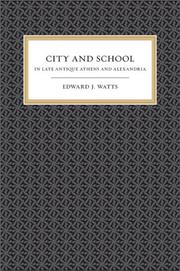
ISBN: 9780520244214 0520244214 Year: 2006 Volume: 41 Publisher: Berkeley University of California press
Abstract | Keywords | Export | Availability | Bookmark
 Loading...
Loading...Choose an application
- Reference Manager
- EndNote
- RefWorks (Direct export to RefWorks)
Education, Ancient --- Education antique --- Athens (Greece) --- Alexandria (Egypt) --- Rome --- Athènes (Grèce) --- Alexandrie (Egypte) --- Intellectual life. --- History --- Vie intellectuelle --- Histoire --- Athènes (Grèce) --- Education --- Iskandarīyah (Egypt) --- Alexandrie (Egypt) --- Aleksandriyah (Egypt) --- Alessandria (Egypt) --- Alexandreia (Egypt) --- Aleksandria (Egypt) --- Alexantreia (Egypt) --- Alesandriʼa (Egypt) --- الإسكندرية (Egypt) --- الإسكندرية (مصر) --- اسكندرية (Egypt) --- Grèce --- Histoire ancienne --- Egypte --- Antiquité --- Empire, 30 av. J.-C.-476
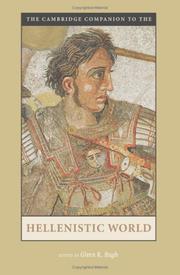
ISBN: 0521828791 9780521828796 9780521535700 0521535700 9781139000949 Year: 2006 Volume: *1 Publisher: Cambridge Cambridge University Press
Abstract | Keywords | Export | Availability | Bookmark
 Loading...
Loading...Choose an application
- Reference Manager
- EndNote
- RefWorks (Direct export to RefWorks)
This Companion volume offers fifteen original essays on the Hellenistic world and is intended to complement and supplement general histories of the period from Alexander the Great to Kleopatra VII of Egypt. Each chapter treats a different aspect of the Hellenistic world - religion, philosophy, family, economy, material culture, and military campaigns, among other topics. The essays address key questions about this period: To what extent were Alexander's conquests responsible for the creation of this new 'Hellenistic' age? What is the essence of this world and how does it differ from its Classical predecessor? What continuities and discontinuities can be identified? Collectively, the essays provide an in-depth view of a complex world. The volume also provides the most recent bibliography on the topics along with recommendations for further reading.
Hellenism. --- Hellénisme --- Mediterranean Region --- Greece --- Méditerranée, Région de la --- Grèce --- History --- Histoire --- Hellénisme --- Méditerranée, Région de la --- Grèce --- Hellenism --- Macedonia --- Méditerranée (région) --- Histoire ancienne --- 323-281 av. J.C. (Domination macédonienne) --- 281-146 av. J.C.
| Listing 1 - 10 of 14 | << page >> |
Sort by
|

 Search
Search Feedback
Feedback About UniCat
About UniCat  Help
Help News
News